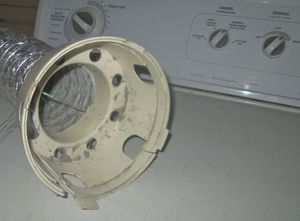Years ago, one popular bit of money-saving advice was to vent the dryer indoors during the winter months. The idea behind venting the dryer indoors was that all that heat and moisture would be directed indoors where it would do some good instead of escaping out into the cold. While in theory this sounds like it would work, it doesn’t. We learned this lesson the hard way after venting our dryer into the house several winters ago as a way to lower our heating bill.
Even though we had done our research and installed an indoor lint trap to catch flying lint, we hadn’t counted on the incredible amount of moisture that was generated by our clothes dryer. Here are the problems that we encountered:
Concentrated humidity. Unlike the humidifier on a furnace, humidity generated from the dryer vent doesn’t circulate throughout the entire house. Instead, it builds up in the laundry room and whatever room it’s directly adjacent to, a little bit like a portable humidifier that you might keep in a child’s room.
Those kiddie humidifiers add moisture to the air at the rate of one gallon per 8 hours, unlike a dryer which churns out a gallon of water each time it dries an average sized load of laundry. This is far more humidity than most homes (including drafty old ones like ours) can handle. The high humidity generated by my dryer caused our kitchen doors swell, some of the kitchen drawers to stick, and even loosened the glue behind wallpaper in parts of the room.
Increased condensation. Along with increased humidity is an increase in condensation. These are the water droplets that form when hot humidity air meets a cold surface such as a window or an uninsulated wall. The moisture generated by my dryer resulted in heavy condensation in several of our rooms. The condensation was bad enough to fog up the windows and caused the paint around the windows, sashes, and doors in the laundry room to crackle.
Increased mold and mildew. It isn’t just damaged paint that a homeowner has to contend with; high humidity can also lead to the growth of mold and mildew in a home. My laundry room is very well ventilated but still developed patchy mold spots on the walls and the french window sills thanks to all that extra humidity. Treating the mold meant scrubbing down the walls with borax, and then sealing everything with a mold sealing primer before repainting.
When it comes to ways to save energy, disconnecting the flex tubing from your dryer and venting it indoors is not a smart strategy at all. You’ll discover like we did that the little energy savings gained from the heated air is quickly offset by the cost of repairing the water damage caused by all that extra moisture.
More by this contributor:
4 easy fixes for a noisy dishwasher.
How to replace the drip pans on a range top stove
How to hook up the ice maker on a new refrigerator.
Reference:
- www.mlive.com/homeandgarden/index.ssf/2008/01/is_it_ok_to_vent_a_dryer_indoo.html
- voices.yahoo.com/venting-dryer-heat-inside-home-safety-5203731.html?cat=6
